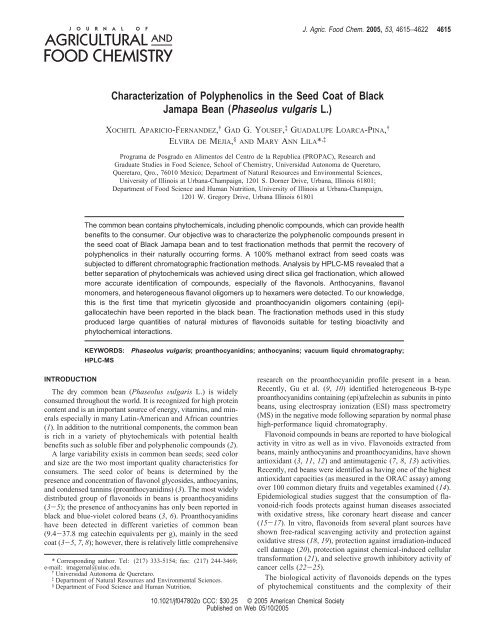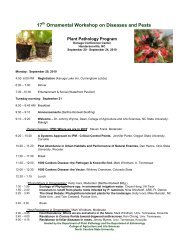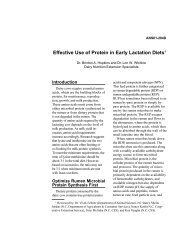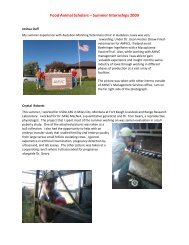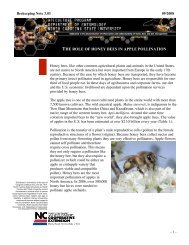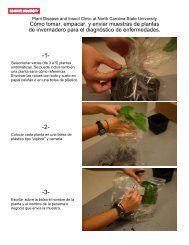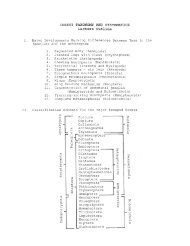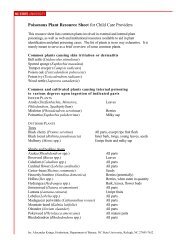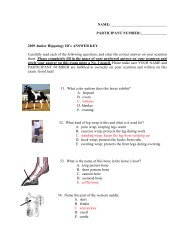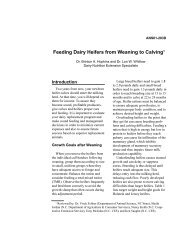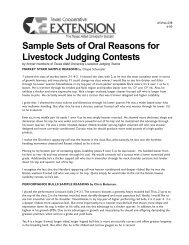Jamapa Bean (Phaseolus vulgaris L.)
Jamapa Bean (Phaseolus vulgaris L.)
Jamapa Bean (Phaseolus vulgaris L.)
Create successful ePaper yourself
Turn your PDF publications into a flip-book with our unique Google optimized e-Paper software.
Characterization of Polyphenolics in the Seed Coat of Black<br />
<strong>Jamapa</strong> <strong>Bean</strong> (<strong>Phaseolus</strong> <strong>vulgaris</strong> L.)<br />
XOCHITL APARICIO-FERNANDEZ, † GAD G. YOUSEF, ‡ GUADALUPE LOARCA-PINA, †<br />
ELVIRA DE MEJIA, § AND MARY ANN LILA* ,‡<br />
Programa de Posgrado en Alimentos del Centro de la Republica (PROPAC), Research and<br />
Graduate Studies in Food Science, School of Chemistry, Universidad Autonoma de Queretaro,<br />
Queretaro, Qro., 76010 Mexico; Department of Natural Resources and Environmental Sciences,<br />
University of Illinois at Urbana-Champaign, 1201 S. Dorner Drive, Urbana, Illinois 61801;<br />
Department of Food Science and Human Nutrition, University of Illinois at Urbana-Champaign,<br />
1201 W. Gregory Drive, Urbana Illinois 61801<br />
The common bean contains phytochemicals, including phenolic compounds, which can provide health<br />
benefits to the consumer. Our objective was to characterize the polyphenolic compounds present in<br />
the seed coat of Black <strong>Jamapa</strong> bean and to test fractionation methods that permit the recovery of<br />
polyphenolics in their naturally occurring forms. A 100% methanol extract from seed coats was<br />
subjected to different chromatographic fractionation methods. Analysis by HPLC-MS revealed that a<br />
better separation of phytochemicals was achieved using direct silica gel fractionation, which allowed<br />
more accurate identification of compounds, especially of the flavonols. Anthocyanins, flavanol<br />
monomers, and heterogeneous flavanol oligomers up to hexamers were detected. To our knowledge,<br />
this is the first time that myricetin glycoside and proanthocyanidin oligomers containing (epi)gallocatechin<br />
have been reported in the black bean. The fractionation methods used in this study<br />
produced large quantities of natural mixtures of flavonoids suitable for testing bioactivity and<br />
phytochemical interactions.<br />
KEYWORDS: <strong>Phaseolus</strong> <strong>vulgaris</strong>; proanthocyanidins; anthocyanins; vacuum liquid chromatography;<br />
HPLC-MS<br />
INTRODUCTION<br />
The dry common bean (<strong>Phaseolus</strong> Vulgaris L.) is widely<br />
consumed throughout the world. It is recognized for high protein<br />
content and is an important source of energy, vitamins, and minerals<br />
especially in many Latin-American and African countries<br />
(1). In addition to the nutritional components, the common bean<br />
is rich in a variety of phytochemicals with potential health<br />
benefits such as soluble fiber and polyphenolic compounds (2).<br />
A large variability exists in common bean seeds; seed color<br />
and size are the two most important quality characteristics for<br />
consumers. The seed color of beans is determined by the<br />
presence and concentration of flavonol glycosides, anthocyanins,<br />
and condensed tannins (proanthocyanidins) (3). The most widely<br />
distributed group of flavonoids in beans is proanthocyanidins<br />
(3-5); the presence of anthocyanins has only been reported in<br />
black and blue-violet colored beans (3, 6). Proanthocyanidins<br />
have been detected in different varieties of common bean<br />
(9.4-37.8 mg catechin equivalents per g), mainly in the seed<br />
coat (3-5, 7, 8); however, there is relatively little comprehensive<br />
* Corresponding author. Tel: (217) 333-5154; fax: (217) 244-3469;<br />
e-mail: imagemal@uiuc.edu.<br />
† Universidad Autonoma de Queretaro.<br />
‡ Department of Natural Resources and Environmental Sciences.<br />
§ Department of Food Science and Human Nutrition.<br />
10.1021/jf047802o CCC: $30.25 © 2005 American Chemical Society<br />
Published on Web 05/10/2005<br />
J. Agric. Food Chem. 2005, 53, 4615−4622 4615<br />
research on the proanthocyanidin profile present in a bean.<br />
Recently, Gu et al. (9, 10) identified heterogeneous B-type<br />
proanthocyanidins containing (epi)afzelechin as subunits in pinto<br />
beans, using electrospray ionization (ESI) mass spectrometry<br />
(MS) in the negative mode following separation by normal phase<br />
high-performance liquid chromatography.<br />
Flavonoid compounds in beans are reported to have biological<br />
activity in vitro as well as in vivo. Flavonoids extracted from<br />
beans, mainly anthocyanins and proanthocyanidins, have shown<br />
antioxidant (3, 11, 12) and antimutagenic (7, 8, 13) activities.<br />
Recently, red beans were identified as having one of the highest<br />
antioxidant capacities (as measured in the ORAC assay) among<br />
over 100 common dietary fruits and vegetables examined (14).<br />
Epidemiological studies suggest that the consumption of flavonoid-rich<br />
foods protects against human diseases associated<br />
with oxidative stress, like coronary heart disease and cancer<br />
(15-17). In vitro, flavonoids from several plant sources have<br />
shown free-radical scavenging activity and protection against<br />
oxidative stress (18, 19), protection against irradiation-induced<br />
cell damage (20), protection against chemical-induced cellular<br />
transformation (21), and selective growth inhibitory activity of<br />
cancer cells (22-25).<br />
The biological activity of flavonoids depends on the types<br />
of phytochemical constituents and the complexity of their
4616 J. Agric. Food Chem., Vol. 53, No. 11, 2005 Aparicio-Fernandez et al.<br />
Figure 1. HPLC-MS output of 100% methanol extract including (A) the total ion current, (B) photodiode array chromatogram, 200−600 nm, and (C) ESI<br />
full mass spectrum, positive mode, m/z 150−2000. Flavonoid compounds were eluted before 40 min as shown by UV maximum absorption (B) while<br />
nonflavonoid compounds did not have UV absorption in the 200−600 nm range.<br />
structures (21, 25) and the composition of the flavonoid<br />
mixtures, since it has been well established that complex<br />
mixtures of phytochemicals in fruits and vegetables may provide<br />
protective health benefits mainly through a combination of<br />
additive or synergistic effects (26, 27). Therefore, it is important<br />
to establish fractionation methods that preserve the integrity of<br />
the structural complexes and that keep phenolic compounds in<br />
the same ratios as they are found in the original food.<br />
Proanthocyanidin extraction from fruits has been commonly<br />
performed using 70% aqueous acetone as solvent; sometimes,<br />
a low percentage of an organic acid is added to favor the<br />
dissolution and extraction of anthocyanins as well (9, 10, 28,<br />
29). Cardador-Martinez et al. (7) reported that 100% methanol<br />
could be an ideal solvent for condensed tannin extraction in<br />
beans, as evaluated by the vanillin quantification method. To<br />
analyze the composition of crude extracts from beans, it is<br />
necessary to fractionate them into simpler mixtures. However,<br />
the process of subfractionation incurs the risk of degrading the<br />
compound’s natural isomeric structures and changing the natural<br />
proportions of interacting phytochemicals. As a result, bioactivity<br />
can be attenuated in the course of chemical characterization.<br />
Proanthocyanidin and anthocyanin molecules can be<br />
sensitive to routine extraction methods and column chromatography.<br />
Commonly, HPLC is used for the separation and identification<br />
of polyphenolics. However, this involves the incorporation<br />
of acids into the extracts or mobile phase that can alter<br />
the chemical structure of polyphenolics (7, 9, 10). Also, the<br />
HPLC technique is only suitable for fractionating small quantities<br />
of plant extracts and can result in the loss of the biological<br />
activity of fractions (30).<br />
Recently, various substrates have been compared for vacuum<br />
liquid chromatography of crude extracts rich in flavonoids and<br />
for obtaining larger amounts of fractions enriched in particular<br />
proanthocyanidin oligomers or mixtures of compounds with<br />
biological activity (29-31). The aim of this study was to<br />
characterize the polyphenolic compounds present in the seed<br />
coat of the Black <strong>Jamapa</strong> bean and to identify fractionation<br />
methods that permit a better characterization of proanthocyanidins<br />
and other major flavonoids in their natural state.<br />
MATERIALS AND METHODS<br />
Plant Material and Standards. The Black <strong>Jamapa</strong> common bean<br />
(<strong>Phaseolus</strong> Vulgaris L. “Black <strong>Jamapa</strong>”) was grown in 2003 at “El<br />
Bajío” Experimental Station of the National Research Institute for<br />
Forestry Agriculture and Livestock (INIFAP), Mexico. The mature dry<br />
seed was stored at -20 °C until separation of seed coats. The seed<br />
coats were lyophilized and stored in the dark at -20 °C until extraction<br />
and further analysis. Authentic commercial standards including anthocyanins<br />
and proanthocyanidins were used to compare retention times.<br />
The anthocyanin standards (delphinidin, petunidin, and malvidin<br />
glycosides) were obtained from Polyphenols Laboratories (Sandnes,<br />
Norway) and proanthocyanidin monomers and dimers, kaempferol,<br />
quercetin, and myricetin glycosides were obtained from Chromadex<br />
(Laguna Hills, CA).<br />
Extraction of Polyphenolics from <strong>Jamapa</strong> <strong>Bean</strong> Seed Coats. To<br />
compare the two most commonly reported methods of proanthocyanidin<br />
extraction, samples of lyophilized seed coats from the same lot of beans<br />
were submitted, independently, to methanol (100%) and acetone<br />
extraction (70% aqueous acetone).<br />
Methanol Extraction. The protocol for the extraction of phenolic<br />
compounds was previously described by Cardador-Martínez et al. (7).
Polyphenolics in Black <strong>Bean</strong> Seed Coats J. Agric. Food Chem., Vol. 53, No. 11, 2005 4617<br />
Figure 2. HPLC-MS output of 70% aqueous acetone extract including (A) the total ion current, (B) photodiode array chromatogram, 200−600 nm, and<br />
(C) ESI full mass spectrum, positive mode, m/z 150−2000. Flavonoid compounds were eluted before 40 min as shown by UV maximum absorption (B)<br />
while nonflavonoid compounds did not have UV absorption in the 200−600 nm range.<br />
Figure 3. MS output of fraction TP3 from 100% methanol extract including the ESI full mass spectrum (m/z 150−2000), showing anthocyanins delphinidin<br />
3-glycoside (m/z 465), petunidin 3-glycoside (m/z 479), malvidin 3-glycoside (m/z 493), and proanthocyanidin dimer (m/z 579) among other polyphenolics<br />
in this fraction.<br />
Lyophilized ground seed coats (70 g) were placed in a flask and<br />
mixed with 100% methanol (1:50, w/v ratio). The flask was shaken<br />
for24hat20°C while wrapped in aluminum foil to protect extract<br />
from light. The sample was then filtered using Whatman #4 paper and<br />
methanol was removed under reduced pressure. The methanol extract<br />
was lyophilized and stored in the dark at -20 °C until HPLC-MS<br />
analysis.<br />
Acetone Extraction. One gram of lyophilized ground seed coat was<br />
sonicated five times with 70% aqueous acetone (15 mL, 4 min each,<br />
followed by filtration on Whatman #4). By the fifth extraction, there<br />
were no more colored substances in the solvent. The extracts were<br />
pooled, the solvent was evaporated under reduced pressure, and the<br />
sample was lyophilized and stored in the dark at -20 °C until HPLC-<br />
MS analysis.<br />
Isolation of Polyphenolics for Identification. Three fractionation<br />
methods were independently applied to separate samples of the 100%<br />
methanol extract, using vacuum liquid chromatography (VLC) with<br />
different column supports including fractionation on Toyopearl (TP),<br />
fractionation on Toyopearl followed by silica gel chromatography<br />
(TPSG), and direct fractionation on silica gel (SG).
4618 J. Agric. Food Chem., Vol. 53, No. 11, 2005 Aparicio-Fernandez et al.<br />
Figure 4. HPLC-MS output of fraction TP5 from 100% methanol extract including (A) the photodiode array chromatogram, 200−600 nm, and (B) ESI<br />
full mass spectrum, m/z 150−2000.<br />
(a) Fractionation on Toyopearl (TP). Lyophilized methanol extract<br />
(0.5 g) dissolved in about 15 mL water was fractionated by VLC on<br />
HW-F40 Toyopearl resin polymer (150 g) (TOSOH Bioseparation<br />
Specialists, Montgomeryville, PA) using a sequential series of solvents<br />
as follows: (1) water, (2) 50% aqueous methanol, (3) 100% methanol,<br />
(4) methanol:acetone (1:1; v/v), (5) 100% acetone, and (6) 50% aqueous<br />
acetone (29-30). The first fraction volume was 250 mL, while the<br />
rest of the fractions were 500 mL. By the end of fractionation, all<br />
colored substances had been removed from the column. The six<br />
fractions obtained (coded TP1, TP2, TP3, TP4, TP5, and TP6) were<br />
evaporated under reduced pressure, lyophilized, and stored at -20 °C<br />
until HPLC-MS analysis.<br />
(b) Fractionation on Toyopearl Followed by Silica Gel (TPSG). The<br />
lyophilized methanol extract (0.5 g) was subjected to Toyopearl VLC<br />
fractionation (150 g) as previously indicated, and then fractions TP2,<br />
TP3, TP4, TP5, and TP6 were remixed, the solvent was removed under<br />
reduced pressure, and the sample was lyophilized. The lyophilized<br />
sample was loaded onto a silica gel column (100 g; silica gel type 60,<br />
10-40 µm with CaSO4 binder) (Sigma). From the VLC on silica gel,<br />
22 fractions were obtained as follows: (1) 100% petroleum ether, (2)<br />
petroleum ether:ethyl acetate (1:1, v/v), (3) 100% ethyl acetate, solvents<br />
used for fractions 4-19 were ethyl acetate with an increasing gradient<br />
of methanol and water (1:1, v/v) (2%, 5%, 8%, 12%, 15%, 20%, 25%,<br />
30%, 35%, 40%, 45%, 50%, 60%, 70%, 80%, 90% of methanol:water<br />
(1:1, v/v), respectively), (20) methanol:water (1:1, v/v), (21) 100%<br />
MeOH, (22) 100% water (29). From the series of 22 subfractions (100<br />
mL each) collected, 7 major fractions were created by recombination<br />
of adjacent subfractions with similar composition on the basis of TLC<br />
(thin-layer chromatography) profiling and Rf values of the spots<br />
observed after vanillin-HCl reaction as described below (fractions TPSG<br />
1-5, TPSG 6-8, TPSG 9-11, TPSG 12-14, TPSG 15-16, TPSG<br />
17-19, and TPSG 20-22).<br />
(c) Direct Silica Gel Fractionation (SG). The 100% methanol extract<br />
(1 g) was directly subjected to silica gel VLC; from the series of<br />
subfractions created, six major fractions were obtained by recombining<br />
adjacent subfractions with similar composition (fractions<br />
SG 1-3, SG 4-8, SG 9-12, SG 13-17, SG 18-20, and SG 20-22)<br />
as described above. The major recombined fractions were evaporated<br />
under reduced pressure, lyophilized, and stored at -20 °C until<br />
HPLC-MS analysis.<br />
Thin-Layer Chromatography of Extracts and Fractions. Thinlayer<br />
chromatography (TLC) was used routinely during fractionation<br />
to monitor the chromatographic separation of phenolic compounds. All<br />
extracts and fractions were tested by TLC using 200-µm thick, 2-25<br />
µm particle size, 60 Å silica gel plates on aluminum (Sigma-Aldrich,<br />
Germany) run with a solvent ratio of ethyl acetate/methanol/water (79:<br />
11:10) as a qualitative test to detect the presence of anthocyanins and<br />
proanthocyanidins (29). TLC plates were visualized separately with<br />
the spray reagents dichromate solution and vanillin-HCl and were<br />
followed by heating at 100 °C for 10 min. The first reagent is used as<br />
a qualitative measure of organic material in samples, while the second<br />
one reacts with flavan 3-ols producing a red coloration indicating the<br />
presence of proanthocyanidins (32).<br />
HPLC-MS Analysis of Composition of Flavonoid-Rich Fractions.<br />
Five mg of each lyophilized sample (crude 100% methanol and 70%<br />
aqueous acetone extracts, TP, TPSG, or SG recombined fractions)<br />
was dissolved in 1 mL aqueous methanol (1:1; v/v) and used for<br />
HPLC-MS analysis. Commercial standards were prepared at a concentration<br />
of 0.5 mg/mL in 50% methanol. The HPLC-MS analyses<br />
were made with an LCQ Deca XP mass spectrometer (Thermo Finnigan<br />
Corp., San Jose, CA), MS version 1.3 SRI, electrospray ionization (ESI)<br />
in the positive ion mode (m/z 150-2000), with a photodiode array<br />
(PDA) detector (200-600 nm), version 1.2, autosampler version 1.2,<br />
and Xcalibur software for data processing. The HPLC separations were
Polyphenolics in Black <strong>Bean</strong> Seed Coats J. Agric. Food Chem., Vol. 53, No. 11, 2005 4619<br />
Table 1. Approximate Ratio of Main Flavonoids Detected by HPLC-MS<br />
in <strong>Bean</strong> 100% Methanol Extract Obtained Using Toyopearl Followed<br />
by Fractionation on Silica Gel (TPSG)<br />
fraction 1−5 6−8 9−11 12−14 15−16 17−19 20−22<br />
Proanthocyanidinsc monomers (C, GC) 6.7 2.5<br />
dimers (A, C, GC) 35.6 9 0.6<br />
trimers (A, C, GC) 25.2 22.1 1.3<br />
tetramers (A, C, GC) 6.3 18.6 3.1 10.5 5.6<br />
pentamers (A, C, GC) 8.6 5.9<br />
hexamers (A, C, GC) 4.5 4.1<br />
total 73.8<br />
Anthocyanins<br />
65.3 14.4 11.1 5.6<br />
delphinidin 3-glycoside 9.3 10.5 8.8 14.5<br />
petunidin 3-glycoside 7.6 7.8 5.2 7.6<br />
malvidin 3-glycoside 9.3 5.7 3.1 4<br />
petunidin diglycoside 4 7.1 6.9<br />
malvidin diglycoside 3.2 6 7.3 5.8<br />
total 3.2<br />
Flavonols<br />
26.2 30.9 31.5 38.8<br />
kaempferol glycoside 8.5 3.5<br />
total 8.5 3.5<br />
not identifiedb 41.5 30.8 29.5<br />
a Values presented to illustrate the relative abundance of compounds, estimated<br />
on the basis of corresponding MS peak heights as explained in text. b Unidentified<br />
compounds of m/z 1069.4, 1085.4, 1253.3, and 1269.3. c C ) catechin/epicatechin;<br />
GC ) gallocatechin/epigallocatechin; A ) afzelechin/epiafzelechin.<br />
carried out on a 150 × 2.1 mm i.d., 5-µm C18 reversed-phase column<br />
Vydac, Western Analytical, Murrieta, CA. The mobile phase consisted<br />
of water with 0.1% formic acid (A) and acetonitrile with 0.1% formic<br />
acid (B). A step gradient of 0%, 5%, 50%, 80%, 100%, and 0% of<br />
solvent B at 3, 4, 30, 42, 50, and 58 min, respectively, a flow rate of<br />
200 µL/min, and an injection volume of 10 µL were employed (29).<br />
The injected volume contained approximately 50 µg of each sample<br />
or 5 µg of each standard.<br />
RESULTS AND DISCUSSION<br />
Methanol versus Aqueous Acetone Extraction. Extracting<br />
bean seed coats using 100% methanol or 70% aqueous acetone<br />
resulted in about 5.7% and 16.6% of dry crude extract (extract<br />
g/seed coats g × 100), respectively. Although aqueous acetone<br />
extraction resulted in a higher percentage of crude extract, it<br />
appeared from HPLC-MS spectra that more nonflavonoid<br />
compounds were present, which may result in interference with<br />
bioactive phenolics in certain bioactivity assays. Initial testing<br />
using thin-layer chromatography (TLC) showed a higher color<br />
intensity and fluorescence of the spots in 100% methanol, and<br />
darker spots after treatment of TLC with dichromate reagent,<br />
from oxidation of the organic material in the extracts. The<br />
number and location of spots on TLC plates were similar<br />
between the two extraction methods. While 70% aqueous<br />
acetone is a widely reported solvent for proanthocyanidin extraction<br />
in many other foods (9, 10, 29), the 100% methanol<br />
extraction method was previously reported for flavonoid extraction<br />
in common bean seed coats and other legumes (7). We<br />
concluded that methanol extraction resulted in a cleaner crude<br />
extract, allowing easier identification and purification of polyphenolics<br />
from bean seed coats. In this study, subsequent fractionation<br />
and identification of polyphenolics in bean seed coats were<br />
performed using the lyophilized 100% methanol extract.<br />
HPLC-MS spectra showed that flavonoid compounds were<br />
eluted before 40 min while nonflavonoid compounds eluted later<br />
(Figures 1 and 2). The figures show total ion current (TIC)<br />
% a<br />
Table 2. Approximate Ratio of Main Flavonoids Detected by HPLC-MS<br />
in <strong>Bean</strong> 100% Methanol Extract Obtained Using Direct Silica Gel<br />
Fractionation (SG)<br />
fraction 1−3 4−8 9−12 13−17 18−20 21−22<br />
Proanthocyanidinsc monomers (C, GC) 13.5<br />
dimers (A, C, GC) 44.7 15.6<br />
trimers (A, C, GC) 8.3 24.7<br />
tetramers (A, C, GC) 12 12.1 6.4 7.3 8.2<br />
pentamers (A, C, GC) 0.8 4.9 6.0<br />
hexamers (A, C, GC) 5.7 4.6 5.1<br />
total 85 61.9 17.5 7.3 8.2<br />
delphinidin 3-glycoside<br />
Anthocyanins<br />
4.1 24.3 6.9 6.1<br />
petunidin 3-glycoside 3.9 16.9 3.1 2.6<br />
malvidin 3-glycoside 4.6 11.8 1.5 1.5<br />
petunidin diglycoside 12 3.1 3.3<br />
malvidin diglycoside 10 3.1 3.1<br />
total 12.6<br />
Flavonols<br />
56.2 17.7 16.5<br />
kaempferol glycoside 5.8<br />
quercetin 3-glycoside 4.1<br />
myricetin glycoside 6.7<br />
total 16.6<br />
not identifiedb 23.1 59.9 58.4<br />
a Values presented to illustrate the relative abundance of compounds, estimated<br />
on the basis of corresponding MS peak heights as explained in text. b Unidentified<br />
compounds of m/z 1069.4, 1085.4, 1253.3, and 1269.3. c C ) catechin/epicatechin;<br />
GC ) gallocatechin/epigallocatechin; A ) afzelechin/epiafzelechin.<br />
which represents the relative abundance of all compounds in<br />
the extract, the maximum wavelength absorption at a range from<br />
200 to 600 nm, and electrospray ionization (ESI) spectra plotted<br />
using a time range from 3 to 40 min. The phenolic compounds<br />
with 200-600 nm absorption were eluted from the HPLC<br />
column within this time range. HPLC-MS spectra indicated that<br />
compounds with the same elution characteristics and molecular<br />
weight were present in both methanol and acetone extracts,<br />
suggesting they were similar in composition.<br />
Composition of Methanol Extracts. (a) Toyopearl Fractionation<br />
(TP). After fractionation of the 100% methanol extract<br />
of seed coats by vacuum liquid chromatography (VLC) on<br />
Toyopearl, the highest quantity of mass was found in fractions<br />
TP1 and TP2 (33% and 28% of total extract, respectively).<br />
Under UV light, TLC plates showed fluorescent spots on the<br />
six fractions indicating the presence of flavonoids. Anthocyanins<br />
in the fractions were examined under visible light where bluepurple<br />
spots on TP2, TP3, and TP4 were observed. Upon<br />
reaction with vanillin-HCl reagent (31), formation of red spots<br />
on TP3, TP4, TP5, and TP6 indicated the presence of proanthocyanidins.<br />
HPLC-MS analysis revealed that Toyopearl fractions were<br />
very complex mixtures of flavonoid and nonflavonoid compounds.<br />
Some of the major compounds were characterized<br />
according to their m/z value, UV spectrum absorbance characteristics,<br />
retention time as compared to commercial standards,<br />
and comparison to previous reports on other food sources of<br />
polyphenols (6, 9, 10, 29, 33-35). Standard retention times were<br />
delphinidin glycoside (11 min), petunidin glycoside (13 min),<br />
malvidin glycoside (14 min), petunidin diglycoside (11 min),<br />
malvidin diglycoside (12 min), kaempferol glycoside (19 min),<br />
quercetin glycoside (12 min), myricetin glycoside (16 min),<br />
proanthocyanidin monomers (20 min), and proanthocyanidin<br />
dimers (11 min). The maximum UV absorption for anthocyanins<br />
% a
4620 J. Agric. Food Chem., Vol. 53, No. 11, 2005 Aparicio-Fernandez et al.<br />
Figure 5. Representative HPLC-MS output of SG 9−12 fraction including (A) the total ion current, (B) photodiode array chromatogram, 200−600 nm,<br />
and (C) ESI full mass spectrum, positive mode, m/z 400−2000. Proanthocyanidins: dimers (m/z 563−611), trimers (m/z 851−899), tetramers (m/z<br />
1139−1187). Anthocyanins: delphinidin 3-glycoside (m/z 465), petunidin 3-glycoside (m/z 479), and malvidin 3-glycoside (m/z 493). Kaempferol, quercetin,<br />
and myricetin glycosides, m/z: 449, 465, and 481, respectively.<br />
was 235 and 525 nm; for proanthocyanidins, 280 nm; for<br />
kaempferol, quercetin, and myricetin glycosides, 360 nm.<br />
Proanthocyanidin dimers in the form of catechin/epicatechin<br />
(m/z 579) and anthocyanins in the form of delphinidin 3-glycoside<br />
(m/z 465), petunidin 3-glycoside (m/z 479), and malvidin<br />
3-glycoside (m/z 493) were identified in fraction TP3 (Figure<br />
3). These results agree with previous reports on the presence<br />
of anthocyanins in black and blue-violet beans (3, 6, 33).<br />
Romani et al. (6) reported traces of diglycosylated anthocyanins<br />
in black Zolfino landraces (P. Vulgaris L.). Other phenolic<br />
compounds with m/z values of 1069.4, 1085.4, 1253.3, and<br />
1269.3 were detected in fraction TP3, with UV maximum<br />
absorption of 280 nm, which suggested they could be proanthocyanidin<br />
oligomers. The difference of 16 mass units between<br />
these compounds suggests that these compounds could be a<br />
series of structurally related compounds with the addition of<br />
an oxygen atom. Further research is needed to completely<br />
identify these compounds.<br />
TP4-TP6 fractions contained higher concentrations of flavan-<br />
3-ol oligomers. TP4 appeared rich in heterogeneous dimers<br />
mainly composed of (epi)afzelechin, (epi)catechin, and (epi)gallocatechin<br />
in addition to some anthocyanins. TP5 contained<br />
a mixture of proanthocyanidin oligomers up to trimers and<br />
smaller quantities of tetramers, pentamers, and hexamers. TP6<br />
contained higher concentrations of tetramers, pentamers, and<br />
hexamers as well as (epi)gallocatechin monomers, dimers, and<br />
trimers compared to TP4 and TP5. Although HPLC reversedphase<br />
C18 columns have the ability to separate oligomers of<br />
equivalent molecular weight into their isomers, isolation of<br />
higher oligomeric proanthocyanidins (g tetramers) was not<br />
feasible. These isomers coeluted in a large unresolved peak<br />
(Figure 4) because of overlapping of the isomers with different<br />
degrees of polymerization or steriochemistry (29, 36).<br />
(b) Toyopearl Fractionation Followed by Silica Gel Fractionation<br />
(TPSG). The percentages of dry weights of the major<br />
fractions TPSG 1-5, 6-8, 9-11, 12-14, 15-16, 17-19, and<br />
20-22 were 4.4%, 0.4%, 2.2%, 4.7%, 25.7%, 35.2%, and<br />
27.4%, respectively, recovered from 0.5 g of dry crude extract.<br />
The main flavonoids detected by mass spectrometry in<br />
TPSG fractions from bean methanol extract are shown in<br />
Table 1. The major fraction TPSG 1-5 contained oily material<br />
of molecular weight and UV absorption not characteristic<br />
of flavonoids, while TPSG 6-8 contained trace amounts<br />
of proanthocyanidin monomers. In TPSG 9-11 fraction, the<br />
most abundant oligomers were those based on (epi)catechin and<br />
small amounts of heterogeneous oligomers, including (epi)afzelechin<br />
and (epi)gallocatechin, and also proanthocyanidin<br />
dimers and trimers, malvidin diglycoside, and kaempferol<br />
glycoside (Table 1).<br />
TPSG 12-14 contained a large number of proanthocyanidins<br />
up to hexamers and anthocyanins. Subsequent TPSG fractions<br />
contained fewer proanthocyanidins but more anthocyanins with<br />
increasing amounts of nonidentified compounds. To estimate<br />
the relative ratio of the proanthocyanidins and anthocyanins in<br />
the TPSG fractions, the HPLC-MS peaks plotted were measured<br />
in millimeters and summed, and each peak was expressed as a<br />
percentage of the total sum (29). These approximate ratios are<br />
presented to show the relative abundance of the detected<br />
polyphenolics in the fractions.<br />
(c) Direct Silica Gel Fractionation (SG). The main flavonoids<br />
detected with this fractionation method are presented in Table<br />
2. The percentages of dry weights of the major fractions SG<br />
1-3, 4-8, 9-12, 13-17, 18-20, and 20-22 were 3.9%, 0.8%,<br />
4.7%, 11.5%, 24.9%, and 54.2%, respectively, recovered when<br />
4 g of dry crude extract was fractionated. The major fraction<br />
SG 4-8 comprised a large number of proanthocyanidins ranging<br />
from monomers to hexamers. Dimers of proanthocyanidin were<br />
the most abundant form in this fraction. SG 9-12 contained a<br />
larger number of higher molecular weight proanthocyanidins<br />
and anthocyanins including delphinidin, petunidin, and malvidin<br />
glycosides. Three flavonols were detected in this major fraction<br />
including kaempferol, quercetin, and myricetin glycosides.<br />
Subsequent SG fractions contained less proanthocyanidins but<br />
more anthocyanins with increasing amounts of nonidentified
Polyphenolics in Black <strong>Bean</strong> Seed Coats J. Agric. Food Chem., Vol. 53, No. 11, 2005 4621<br />
compounds as was observed above with TPSG fractions. An<br />
HPLC-MS output showing the total ion current chromatogram<br />
for the major SG 9-12 fraction and the corresponding photodiode<br />
array and ESI mass spectrum is shown in Figure 5.<br />
Gu et al. (9-10) reported the presence of proanthocyanidins<br />
made up of heterogeneous subunits in three varieties of P.<br />
Vulgaris: pinto bean, small red bean, and red kidney bean.<br />
However, they found (epi)catechin as terminal units and (epi)afzelechin<br />
(propelargonidins) and (epi)catechin (procyanidins)<br />
as extension units but did not detect (epi)gallocatechin (prodelphinidins)<br />
as we did in this report. The presence of<br />
prodelphinidins has been reported in lentils (34). Kaempferol<br />
glycoside, myricetin, and quercetin glycosides were present in<br />
SG 9-12 fractions (Table 2). The presence of kaempferol and<br />
quercetin glycosides has been detected previously in different<br />
varieties of common bean (3, 6), but to our knowledge, this is<br />
the first time that myricetin glycoside has been detected in bean.<br />
Toyopearl resin polymer is typically used to remove sugars<br />
and pectins from phenolic compounds in plant natural product<br />
extracts (29). However, no significant amount of sugar was<br />
detected in these bean seed coats. For this reason, and on the<br />
basis of our results from this comparative study, we suggest<br />
that direct fractionation using silica gel results in faster and more<br />
efficient fractionation of bean flavonoids. The inclusion of the<br />
initial Toyopearl fractionation step increases the time and<br />
number of steps required to accomplish separation, which could<br />
diminish the bioactive potential of some extracts. While a<br />
Toyopearl initial fractionation has been extremely useful for<br />
separation of pectin-rich berry fruit extracts, it was not essential<br />
for bean seed coat extracts.<br />
Although HPLC separation of compounds from direct silica<br />
gel fractionation (SG) was better than those from TP and TPSG,<br />
SG fractions were still a complex mixture of flavonoid and<br />
nonflavonoid compounds. To completely characterize the 100%<br />
methanol extracts from beans, it will be necessary to further<br />
fractionate silica gel fractions, possibly using repeated fractionation<br />
steps on Sephadex LH20. We have repeatedly used silica<br />
gel for successful subfractionation of flavonoid-rich fractions<br />
in our laboratory (29-31). Similarities within the proanthocyanidin<br />
profiles obtained here and reported previously suggest the<br />
fractionation method is reproducible and reliable for obtaining<br />
similar fractions each time.<br />
The direct silica gel fractionation (SG) yielded a more<br />
streamlined and faster separation of phenolic compounds in<br />
natural mixtures that can be suitable for testing in bioactivity<br />
assays, especially those which require large quantities for valid<br />
activity determinations. Because potentiating interactions (synergies,<br />
additive effects) may well play a role in the bioactivity of<br />
fruit and vegetable natural extracts (26-27), it is particularly<br />
important to maintain natural mixtures at least during early<br />
stages of the fractionation and purification process.<br />
ACKNOWLEDGMENT<br />
We thank Dr. David Seigler, Department of Plant Biology,<br />
University of Illinois, for consultation.<br />
LITERATURE CITED<br />
(1) Shellie-Dessert, K. C.; Bliss, F. A. Genetic improvement in food<br />
quality factors. In Common <strong>Bean</strong>s: Research for Crop ImproVement;<br />
Schoonoven, A., van-Voysest, O., Eds.; CAB International:<br />
Wallinford, U.K., 1991; pp 649-673.<br />
(2) Guzmán-Maldonado, S. H.; Paredes-López, O. Functional products<br />
of plants indigenous to Latin America: Amaranth, quinoa,<br />
common beans and botanicals. In Functional Foods. Biochemical<br />
and Processing Aspects; Mazza, G., Ed.; Technomic: Lancaster,<br />
PA, 1998; pp 239-328.<br />
(3) Beninger, C. W.; Hosfield, G. L. Antioxidant activity of extracts,<br />
condensed tannin fractions, and pure flavonoids from <strong>Phaseolus</strong><br />
Vulgaris L. seed coat color genotypes. J. Agric. Food Chem.<br />
2003, 51, 7879-7883.<br />
(4) Guzmán-Maldonado, S. H.; Castellanos, J.; González de Mejía,<br />
E. Relationship between theoretical and experimentally detected<br />
tannin content of common beans (<strong>Phaseolus</strong> Vulgaris L.). Food<br />
Chem. 1996, 55, 333-335.<br />
(5) De Mejia, E.; Guzman-Maldonado, S. H.; Acosta-Gallegos, J.<br />
A.; Reynoso-Camacho, R.; Ramirez-Rodriguez, E.; Pons-Hernandez,<br />
J. L.; Gonzalez-Chavira, M. M.; Castellanos, J. Z.; Nelly,<br />
J. D. Effect of cultivar and growing location on the trypsin<br />
inhibitors, tannins and lectins of common beans (<strong>Phaseolus</strong><br />
Vulgaris L.) grown in semiarid highlands of Mexico. J. Agric.<br />
Food Chem. 2003, 51, 5962-5966.<br />
(6) Romani, A.; Vignolini, P.; Galardi, C.; Mulinacci, N.; Benedettelli,<br />
S.; Heimler, D. Germplasm characterization of Zolfino<br />
landraces (<strong>Phaseolus</strong> Vulgaris L.) by flavonoid content. J. Agric.<br />
Food Chem. 2004, 52, 3838-3842.<br />
(7) Cardador-Martínez, A.; Castaño-Tostado, E.; Loarca-Piña, G.<br />
Antimutagenic activity of natural phenolic compounds in the<br />
common bean (<strong>Phaseolus</strong> Vulgaris) against aflatoxin B1. Food<br />
Addit. Contam. 2002, 19, 62-69.<br />
(8) Aparicio-Fernández, X.; Manzo-Bonilla, L.; Loarca-Piña, G.<br />
Comparison of antimutagenic activity of phenolic compounds<br />
in newly harvested and stored common beans <strong>Phaseolus</strong> Vulgaris<br />
against aflatoxin B1. J. Food Sci. 2005, 70, S73-78.<br />
(9) Gu, L.; Kelm, M. A.; Hammerstone, J. F.; Zhang, Z.; Beecher,<br />
G.; Holden, J.; Haytowitz, D.; Prior, R. L. Liquid chromatographic/<br />
electrospray ionization mass spectrometric studies of proanthocyanidins<br />
in foods. J. Mass Spectrom. 2003, 38, 1272-1280.<br />
(10) Gu, L.; Kelm, M. A.; Hammerstone, J. F.; Beecher, G.; Holden,<br />
J.; Haytowitz, D.; Prior, R. L. Screening of foods containing<br />
proanthocyanidins and their structural characterization using<br />
LC-MS/MS and thyolitic degradation. J. Agric. Food Chem.<br />
2003, 51, 7513-7521.<br />
(11) Tsuda, T.; Ohshima, K.; Kawakishi, S.; Osawa, T. Antioxidative<br />
pigments isolated from the seeds of <strong>Phaseolus</strong> Vulgaris L. J.<br />
Agric. Food Chem. 1994, 42, 248-251.<br />
(12) Cardador-Martínez, A.; Loarca-Piña, G.; Oomah, B. D. Antioxidant<br />
activity in common beans (<strong>Phaseolus</strong> Vulgaris L.). J.<br />
Agric. Food Chem. 2002, 50, 6975-6980.<br />
(13) González de Mejía, E.; Castaño-Tostado, E.; Loarca-Piña, G.<br />
Antimutagenic effects of natural phenolic compounds in beans.<br />
Mutat. Res. 1999, 44, 1-9.<br />
(14) Wu, X. L.; Beecher, G. R.; Holden, J. M.; Haytowitz, D. B.;<br />
Gebhardt, S. E.; Prior, R. L. Lipophilic and hydrophilic antioxidant<br />
capacities of common foods in the United States. J.<br />
Agric. Food Chem. 2004, 52, 4026-4037.<br />
(15) Duthie, G. G.; Duthie, S. J.; Kyle, J. A. M. Plant polyphenols in<br />
cancer and heart disease: Implications as nutritional antioxidants.<br />
Nutr. Res. ReV. 2000, 13, 79-106.<br />
(16) Renaud, S.; de Lorgeril, M. Wine, alcohol, platelets and French<br />
paradox of coronary heart disease. Lancet 1992, 339, 1523-<br />
1526.<br />
(17) Lambert, J. D.; Yang, C. S. Mechanisms of cancer prevention<br />
by tea constituents. J. Nutr. 2003, 133, 3262S-3267S.<br />
(18) Bagchi, D.; Kuszynski, C. A.; Balmoori, J. Hydrogen peroxideinduced<br />
modulation of intracellular oxidized states in cultured<br />
macrophage J774A.1 and neuroactive PC-12 cells, and protection<br />
by a novel IH636 grape seed proanthocyanidin extract. Phytother.<br />
Res. 1998, 12, 568-571.<br />
(19) Youdim, K. A.; Martin, A.; Joseph, J. A. Incorporation of<br />
elderberry anthocyanins by endothelial cells increases protection<br />
against oxidative stress. Free Radical Biol. Med. 2000, 29,<br />
51-60.
4622 J. Agric. Food Chem., Vol. 53, No. 11, 2005 Aparicio-Fernandez et al.<br />
(20) Kondo, H.; Park, S. H.; Watanabe, K.; Yamamoto, Y.; Akashi,<br />
M. Polyphenol (-)-epigallocatechin gallate inhibits apoptosis<br />
induced by irradiation in human HaCaT keratinocytes. Biochem.<br />
Biophys. Res. Commun. 2004, 316, 59-64.<br />
(21) Hou., D. X.; Kai, K.; Li, J. J.; Lin, S.; Terahara, N.; Wakamatsu,<br />
N.; Fujii, M.; Young, M. R.; Colburn, N. Anthocyanidins inhibit<br />
activator protein 1 activity and cell transformation: structureactivity<br />
relationship and molecular mechanism. Carcinogenesis<br />
2004, 25, 29-36.<br />
(22) Rafi, M. M.; Vastano, B. C.; Zhu, N.; Ho, C.; Ghai, G.; Rosen,<br />
R. T.; Gallo, M. A.; DiPaola, R. S. Novel polyphenol molecule<br />
isolated from licorice root (Glycrrhiza glabra) induces apoptosis,<br />
G2/M cell cycle arrest, and Bcl-2 phosphorylation in tumor cell<br />
lines. J. Agric. Food Chem. 2002, 50, 677-684.<br />
(23) Katsube, N.; Iwashita, K.; Tsushida, T.; Yamaki, K.; Kobori,<br />
M. Induction of apoptosis in cancer cells by bilberry (Vaccinium<br />
myrtillus) and the anthocyanins. J. Agric. Food Chem. 2003, 51,<br />
68-75.<br />
(24) Hakimuddin, F.; Paliyath, G.; Meckling, K. Selective cytotoxicity<br />
of a red grape wine flavonoid fraction against MCF-7 cells.<br />
Breast Cancer Res. Treat. 2004, 85, 65-79.<br />
(25) Lazzè, M. C.; Savio, M.; Pizzala, R.; Cazzalini, O.; Perucca, P.;<br />
Scovassi, A. I.; Stivala, L. A.; Bianchi, L. Anthocyanins induce<br />
cell cycle perturbations and apoptosis in different human cell<br />
lines. Carcinogenesis 2004, 25, 1427-1433.<br />
(26) Seeram, N. P.; Adams, L. S.; Hardy, M. L.; Heber, D. Total<br />
cranberry extract versus its phytochemical constituents: antiproliferative<br />
and synergistic effects against human tumor cell<br />
lines. J. Agric. Food Chem. 2004, 52, 2512-2517.<br />
(27) Shafiee, M.; Carbonneau, M.; Huart, J.; Descomps, B.; Leger,<br />
C. Synergistic antioxidative properties of phenolics from natural<br />
origin toward low density lipoproteins depend on the oxidation<br />
system. J. Med. Food 2002, 5, 69-78.<br />
(28) Lazarus, S. A.; Adamson, G. E.; Hammerstone, J. F.; Schmitz,<br />
H. H. High-performance liquid chromatography/mass spectrometry<br />
analysis of proanthocyanidins in fruits and beverages. J.<br />
Agric. Food Chem. 1999, 47, 3693-3701.<br />
(29) Yousef, G. G.; Seigler, D. S.; Grusak, M. A.; Rogers, R. B.;<br />
Knight, C. T. G.; Kraft, T. F. B.; Erdman, J. W.; Lila, M. A.<br />
Biosynthesis and characterization of 14 C-enriched flavonoid<br />
fractions from plant cell suspension cultures. J. Agric. Food<br />
Chem. 2004, 52, 1138-1145.<br />
(30) Schmidt, B. M.; Howell, A. B.; McEniry, B.; Knight, C. T.;<br />
Seigler, D. S.; Erdman, J. W.; Lila, M. A. Effective separation<br />
of potent antiproliferation and antiadhesion components from<br />
wild blueberry (Vaccinium angustifolium Ait.) fruits. J. Agric.<br />
Food Chem. 2004, 52, 6433-6442.<br />
(31) Kandil, F. E.; Smith, M. A. L.; Rogers, R. B.; Pépin, M. F.;<br />
Song, L.; Pezzuto, J. M.; Seigler, D. S.; Composition of a<br />
chemopreventive proanthocyanidin-rich fraction from cranberry<br />
fruits responsible for the inhibition of 12-O-tetradecanoyl phorbol-13-acetate<br />
(TPA)- induced ornithine decarboxylase (ODC)<br />
activity. J. Agric. Food Chem. 2002, 50, 1063-1069.<br />
(32) Sun, B. S.; Ricardo-da-Silva, J. M.; Spranger, I. Critical factors<br />
of vanillin assay for catechin and proanthocyanidins. J. Agric.<br />
Food Chem. 1998, 46, 4267-4274.<br />
(33) Choung, M. G.; Choi, B. R.; An, Y. N.; Chu, Y. H.; Cho, Y. S.<br />
Anthocyanin profile of Korean kidney bean (<strong>Phaseolus</strong> Vulgaris<br />
L). J. Agric. Food Chem. 2003, 51, 7040-7043.<br />
(34) Dueñas, M.; Sun, B.; Hernandez, T.; Estrella, I.; Spranger, M.<br />
I. Proanthocyanidin composition in the seed coat of lentils (Lens<br />
culinaris L.). J. Agric. Food Chem. 2003, 51, 7999-8004.<br />
(35) Garcia-Beneytez, E.; Cabello, F.; Revilla, E. Analysis of grape<br />
and wine anthocyanins by HPLC-MS. J. Agric. Food Chem.<br />
2003, 51, 5622-5629.<br />
(36) Wilson, E. L. High-pressure liquid chromatography of apple juice<br />
phenolic compounds. J. Sci. Food Agric. 1981, 32, 257-264.<br />
Received for review December 28, 2004. Revised manuscript received<br />
April 14, 2005. Accepted April 14, 2005. The authors wish to thank<br />
the United States Agency for International Development through a<br />
grant from the Association Liaison Office for University Cooperation<br />
in Development (TIES-Enlaces/US-AID), Consejo Nacional de Ciencia<br />
y Tecnología (CONACYT) grant 31623-B, and USDA/IFAFS grant #<br />
00-52101-9695.<br />
JF047802O


